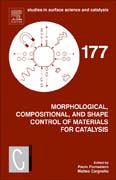
Morphological, Compositional, and Shape Control of Materials for Catalysis
Fornasiero, Paolo
Cargnello, Matteo
Morphological, Compositional, and Shape Control of Materials for Catalysis, Volume 177, the latest in the Studies in Surface Science and Catalysis series, documents the fast-growing developments in the synthesis, characterization, and utilization of nanostructures for catalysis. The book provides essential background on using well-defined materials for catalysis and presents exciting new paradigms in the preparation and application of catalytic materials, with an emphasis on how structure determines catalytic properties. In addition, the book uniquely features discussions on the future of the field, with ample space for future directions detailed in each chapter. Presents the latest paradigms in the preparation and application of catalytic materialsProvides essential background on using well-defined materials for catalysisFeatures discussion of future directions at the end of each chapter INDICE: 1. Opportunities and challenges in the synthesis, characterization, and catalytic properties of controlled nanostructuresMichele Melchionna, Paolo Fornasiero, Matteo Cargnello2. Tuning product selectivity by changing the size of catalytically-active metallic nanoparticlesElad Gross3. Achievements, present status, and grand challenges of controlled model nano-catalystsSelim Alayoglu4. Well-defined metal nanoparticles for electrocatalysisLiheng Wu, Zheng Xi, and Shouheng Sun5. Characterization of model nanocatalysts by x-ray absorption spectroscopyQi Wang and Anatoly I. Frenkel6. Controlling the number of atoms on catalytic metallic clustersAlejandra Londoño-Calderon, Arturo Ponce, Ulises Santiago, Sergio Mejia, and Miguel José-Yacamán7. Spectroscopic methods in catalysis and their applications in well-defined nanocatalystsElisa Borfecchia, Lorenzo Mino, Elena Groppo, Silvia Bordiga, Aram L. Bugaev, Andriy Budnyk, Kirill A. Lomachenko, Alexander A. Guda, Mikhail A. Soldatov, Alexander V. Soldatov, and Carlo Lamberti8. Nanoscale control of metal clusters on templating supportsErik Vesselli and Maria Peressi9. 0, 1, 2, and 3-D soft and hard templates for catalysisSultan Butuna, Sahin Demircia, Alper O. Yasara, Selin Sagbasa, Nahit Aktasc, Nurettin Sahinera10. Atomically precise gold and bimetal nanoclusters as new model catalystsChenjie Zeng, Yuxiang Chen, Shuo Zhao, and Rongchao Jin11. Fundamental studies on photocatalytic structures with well-defined crystal facetsDon Jiang and Wenzhong Wang12. Nanocrystal catalysts of high energy surface and high activityShi-Gang Sun13. Synthesis and characterization of morphology controlled TiO2 nanocrystals: Opportunities and challenges for their application in photocatalytic materialsMassimiliano D'Arienzo, Roberto Scotti, Barbara Di Credico, and Matteo Redaelli14. Uncertainties in theoretical description of well defined heterogeneous catalystsZhi-Jian Zhao and Jinlong Gong 15. Sn-substituted zeolites as heterogeneous catalysts for liquid phase catalytic technologiesCeri Hammond16. Discovering and utilizing structure sensitivity: from chemical catalysis in the gas phase to electrocatalysis in the liquid phaseHailiang Wang17. Well-defined nanostructures for catalysis by atomic layer depositionYomaira J. Pagán-Torres, Junling Lu, Eranda Nikolla, and Ana C. Alba-Rubio
- ISBN: 978-0-12-805090-3
- Editorial: Elsevier
- Encuadernacion: Cartoné
- Páginas: 706
- Fecha Publicación: 10/05/2017
- Nº Volúmenes: 1
- Idioma: Inglés
